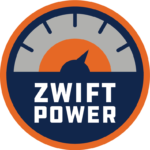Enter Here: https://www.zwift.com/uk/events/tag/cirwbseries
Team RWB – Racing Without Borders presents a points based eSports Series – fast & furious racing across all categories. We are happy to Partner with Cycling Ireland to Promote their 2023/24 eSports Series through our League. Visit https://www.cyclingireland.ie/cycling/virtual to find out more.
Cycling Ireland Member Enter here:
https://eventmaster.ie/event/A9jwsjlIlv
To appear in results please make sure you are signed up to Zwiftpower.com. We hope everyone goes full gas and enjoys the race #rideOn
The 2023/24 eSports Winter series kicks off on October 27th and will run for Twelve rounds. eSports Racing is among the fastest growing disciplines in world cycling and Zwift Racing has been a huge platform of enablement. Participants will race over twelve rounds kicking off weekly from October 27th 2023 to January 19th 2024 across several Zwift courses and worlds – with the best eight of twelve rounds counting towards final standings. Register for the Cycling Ireland Zwift Series here to appear on the Cycling Ireland results. (You need to hold a current Cycling Ireland membership to appear on the results table.)
– Points will be awarded for finishing places in each round, while fastest time segment points are also awarded for the top ten in each round.
– There are four open categories, ranging from A to D.
SCHEDULE
RACE 1.
Downtown Titans // Watopia
Prime: Zwift KOM
27.10.23 @19:05 GMT
RACE 2.
Rolling Highlands // Scotland
Prime: Breakaway Brae
03.11.23 @19:05 GMT
RACE 3.
Queens Highway // Yorkshire
Prime: Yorkshire sprint rev
10.11.23 @19:05 GMT
RACE 4.
Park Perimeter Loop // New York
Prime: ny sprint
17.11.23 @19:05 GMT
RACE 5.
Greater London Loop// London
Prime: Box Hill
24.11.23 @19:05 GMT
RACE 6.
Glasgow Crit // Scotland
Prime: Clyde kicker
01.12.23 @19:05 GMT
RACE 7.
Temples and Towers // Makuri island
Prime: Temple KOM
08.12.23 @19:05 GMT
RACE 8.
Innsbruckring // Innsbruck
Prime: Leg Snapper KOM
15.12.23 @19:05 GMT
RACE 9.
Libby Hill After Party // Richmond
Prime: Monument Ave Sprint
22.12.23 @19:05 GMT
RACE 10.
Magnificent 8 // Watopia
Prime: Zwift kom
05.01.24 @19:05 GMT
RACE 11.
R.G.V. // France
Prime: Aqueduc KOM rev
12.01.24 @19:05 GMT
RACE 12.
New Watopia Roads
Details Released Mid-November
19.01.24 @19:05 GMT
FINISHING POINTS
1st – 30pts
2nd – 25pts
3rd – 20pts
4th – 19pts
5th – 18pts
6th – 17pts
7th – 16pts
8th – 15pts
9th – 14pts
10th – 13pts
11th → 15th – 10pts
16th → 20th – 9pts
21st → 25th – 8pts
26th → 30th – 7pts
31st → 35th – 6pts
36th → 40th – 5pts
41st → 45th – 4pts
46th → 50th – 3pts
51st → 55th – 2pts
56th → > 1pts
FASTEST TIME SEGMENT POINTS
1st – 20pts
2nd – 15pts
3rd – 10pts
4th – 7pts
5th – 6pts
6th – 5pts
7th – 4pts
8th – 3pts
9th – 2pts
10th – 1pt
NOTES
– All participants finishing outside point scoring will score 1 point.
– Points scoring applied to each category (A,B,C,D).
– The Best 8 of 12 rounds count to the final standings.
– Each Round of Results will be available on Zwiftpower.
– The Points for Primes are the top 10 Fastest Timed Segments. Some routes have multiple chances to best your time or beat a rival.
– Category Enforcement will be used.
– Heart rate monitors are mandatory in Categories A, B & C and are advised for D.
– Only power meter and smart trainer users are eligible for official result placement in Categories A, B & C but are advised for D.
– No TT bikes permitted.
– Power ups permitted.
– We reserve the right to DQ riders based on unsportsmanlike conduct of rider or team or ask for verification in specific cases especially in A.
– All disputes to be directed towards RWB, either Facebook Messenger or via email info@withoutborders.online.
– There will be two sets of results: Zwift Power & Cycling Ireland. Riders must be registered on Zwift Power to be included in results.
– The official CYCLING IRELAND results will be published only including Cycling Ireland members that have registered via Eventmaster.
– Cycling Ireland results to be published on Monday at: https://www.cyclingireland.ie/cycling/esports/
RWB RACING
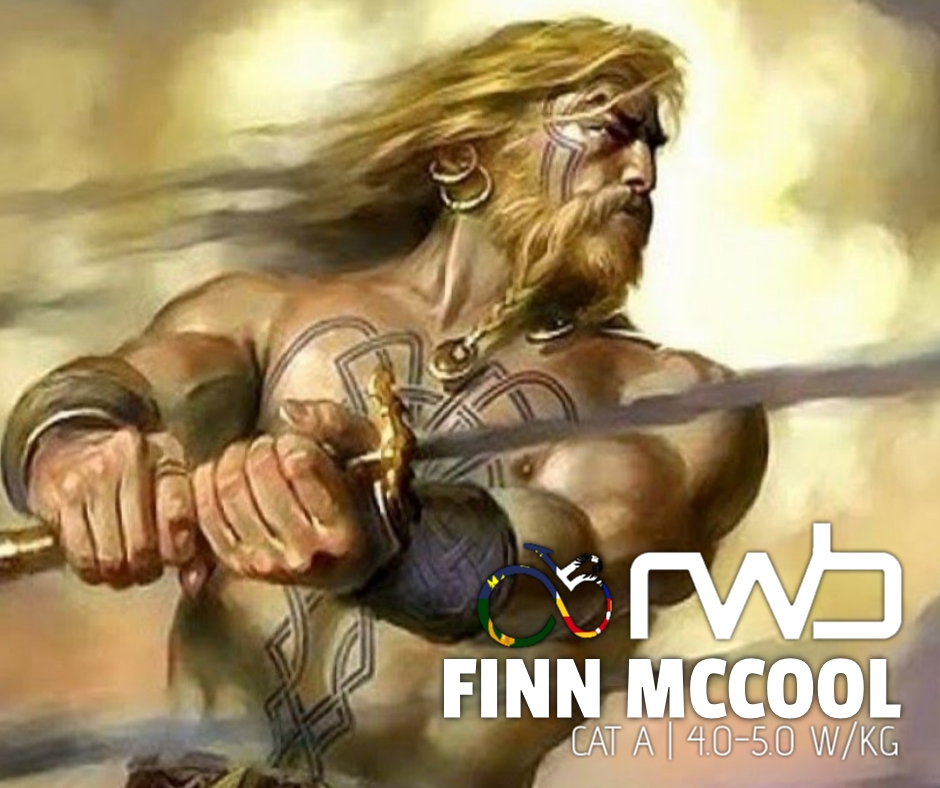
Finn McCool | Cat A | 4.1-5.0 W/Kg | Mixed
Finn McCool, Ulster warrior and commander of the King of Ireland’s armies, is renowned for his amazing feats of strength. Once during a fight with a giant, he scooped up a huge clod of earth and threw it at his rival. Legend says that the clod fell into the sea and became the Isle of Man, while the depression left behind filled with water and became Lough Neagh.
Some tales say that Finn fell in love with a lady giant on the island of Staffa in the Hebrides and that he built the Giant’s Causeway to bring her over to him without getting his feet wet. However, the legend below is the explanation most commonly used.
The story goes that Finn was going about his daily duties in Northern Ireland when one of his enemies, a Scottish giant named Benandonner, who lived in Fingal’s Cave on the island of Staffa in the Hebrides, started shouting out insults at him. He was rude to Finn and said he was weak and no good at fighting.
Benandonner eventually got so angry that he shouted to Finn. “If I could get my hands on you I would make sure you are never able to fight again.” But he added, “Unfortunately I cannot swim so I am not able to get over to you and we shall never know who is the stronger of the two.”
Finn was so enraged that he tore large pieces out of the nearby cliffs and rammed them down into the seabed, making a causeway between Northern Ireland and Staffa. “Now you’ll have no excuse,” he shouted across to Benandonner.
When Finn caught sight of Benandonner as he started to cross the causeway he realised how gigantic his Scottish rival was and thought that perhaps he had taken on more than he could manage.
So he devised a clever plan. He decided to lie down and pretend to be asleep, but before he did that he quickly made himself a large child’s cot and disguised himself in baby’s clothes.
When the Scottish giant arrived at Finn’s house he shouted, “Where is that coward MacCool?” Then he noticed the cot and the sleeping ‘baby’ inside it and he suddenly felt very afraid. He thought, “My goodness, if this is the size of the baby, what size must the father be?”
Without waiting around to find out, he turned on his heels and ran like he had never run before. He raced back across to Scotland, destroying the causeway as he went, so that Finn could not come after him. And that is why only two fragments of the causeway now remain, one end on the coast of Northern Ireland and the other on the Hebridean island of Staffa.
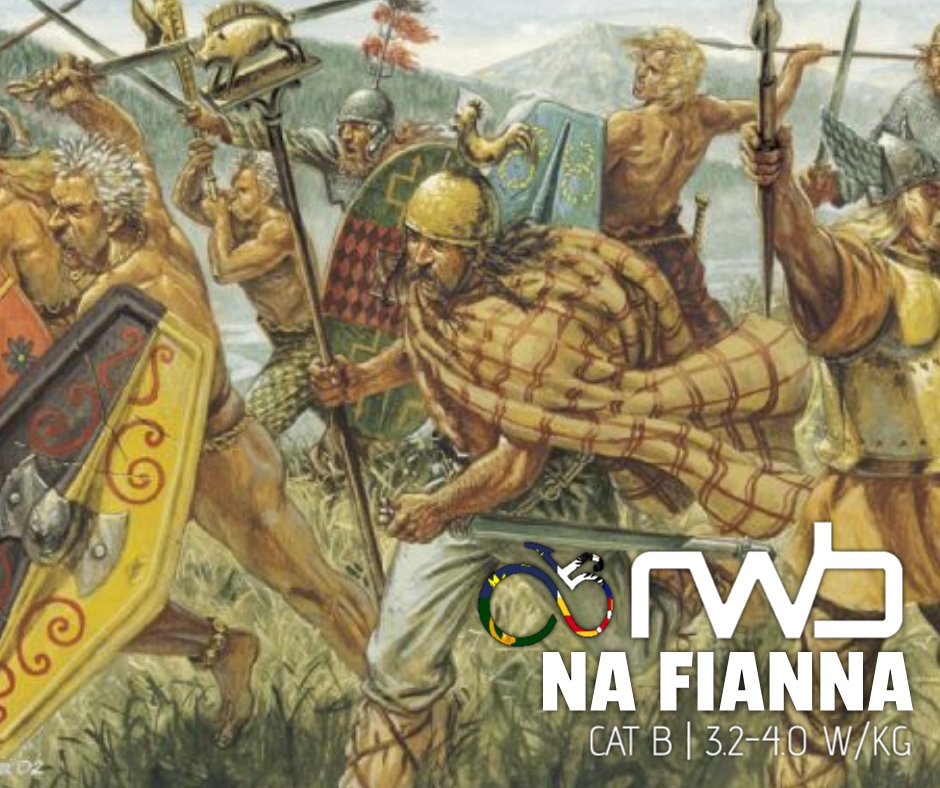
Na Fianna | Cat B | 3.2-4.0 W/Kg | Mixed
The Fianna was made up of many battalions called cathas, each with 3,000 warriors. In peaceful times, the main body of the Fianna was made up on three cathas, or about 9,000 fighting men, while in times of war this could expand to seven cathas, or 21,000 trained, agile, and toughened noble warriors.
The Fianna were more than just a gang of good fighters. Members were also required to be of the highest intellectual caliber, skilled in poetry, music, geneologies, and the histories of the lands and their peoples. The Fianna was at once a warriors’ training academy and a heroes’ guild. At the core of this great crowd sat Fionn as the central sun with his selected comrades orbitting closest to him.
The Fianna stood as protectors of the established Gaelic order. They supported the high-king and upheld the values and ethics of their warrior-code, protecting the people and defending the land as and when occassion, or principle, demands it. Surely a mighty force, one that king’s sought to keep in their own favour – paying tributes and respect to the Fianna through transfers of great wealth and land to the order.
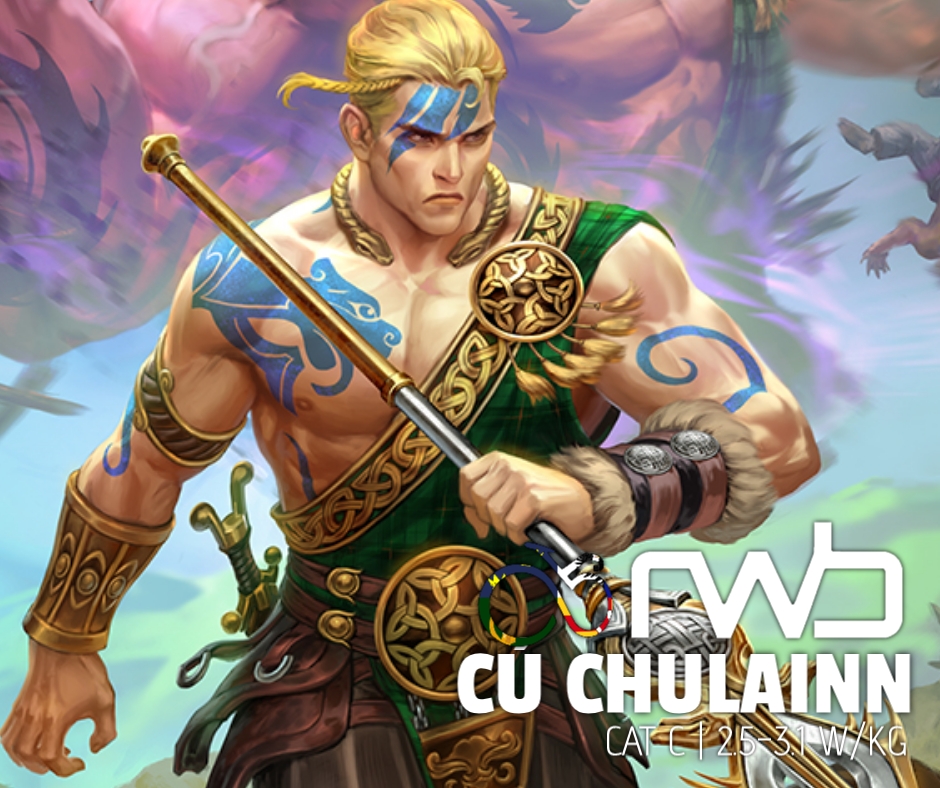
CúChulainn | Cat C | 2.4-3.1 W/Kg | Mixed
The adventures of Cuchulainn (pronounced Cou-hou-linn) are spread across seventy-six tales contained in the collection of stories known as the Ulster cycle, which tell of the Ulaidh, the ancient people from whom the province of Ulster got its name. Cuchulainn is one of the greatest heroes of Celtic mythology, and the story of his exploits, though not found in a single, continuous, comprehensive narrative, has all the features of an epic.
Cuchulainn is the son of Dechtire, the sister of King Conchobar (pronounced Connor), who is married to the prophet Sualtim. But Cuchulainn’s real father is Lug, god of light, and master of all crafts. Cuchulainn is brought up in the court of King Conchobar, along with the sons of the Knights of the Red Branch, a chivalrous order of knights to which the warriors of Ulster belonged.
Even as a little boy, Cuchulainn showed exceptional promise as a warrior. It is said that he possessed great strength, and that when he was angry, his body would radiate intense heat and would become misshapen and ugly. His early exploits include the killing of the ferocious hound of Culain, the chief smith of Ulster, and the massacre of three giant warriors who had defied the Red Branch Knights.
Cuchulain completed his education under the witch Scathach (pronounced Scaw-ha), who lived on the island of Alba (Scotland) and taught Cuchulain magic as well as the art of war.
His most famous exploits are related in the twenty tales that make up the central saga in the Ulster cycle – the Táin Bó Cuailnge: The Cattle Raid of Cooley. This is the story of the long war waged by the men of Connaught under their queen Medb (pronounced Mev) against the men of Ulster under Conchobar. Medb wanted possession of a magic animal, the Brown Bull of Cooley, which was owned by one of the chieftains of Ulster.
Medb attacks the men of Ulster at a time when they are suffering from a strange weakness inflicted on them by the goddess Macha as punishment for having once made fun of her. Of all the warriors of Ulster, only Cuchulainn, who is the son of a god and therefore unaffected by Macha’s revenge, is able to fight. He single-handedly holds off the enemy, though helped by his father Lug, the god of light, and by Morrigan, the goddess of war.
Other tales tell of Cuchulainn’s loves, of his only son Conlach whom he kills by mistake, and of his subsequent madness as he grieves for his child.
Cuchulainn, finally killed by the trickery of Queen Medb, dies young, according to a prophecy that was made when he was a boy. He dies standing, tied to a pillar of stone with his own belt, and with his face turned valiantly towards his enemy. His life and adventures occur during the reign of King Conchobar mac Nessa who ruled, it is said, between 30 BCE and 33 CE.
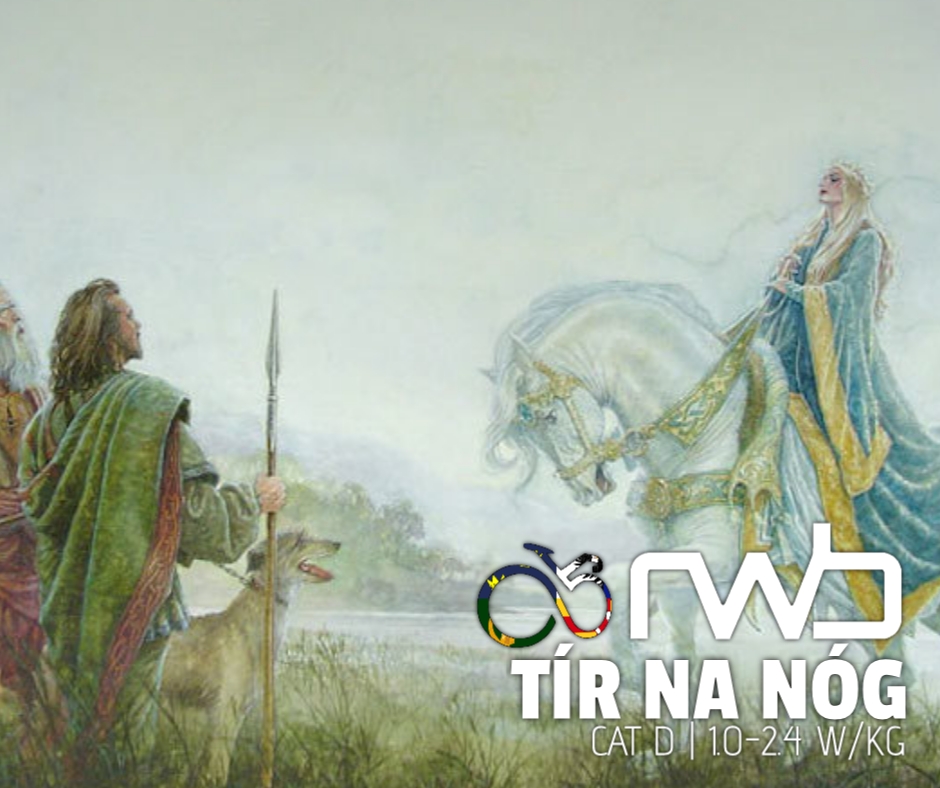
Tír na nÓg | Cat D | 1.0-2.4 W/Kg | Mixed
One of the world’s most famous Irish legends, the tale of Tír Na nÓg, a paradise and supernatural realm of everlasting youth, beauty, health, abundance, and joy.
The best known tale of Tir na nOg is the story of the young Irish warrior Oisin, who fell in love with the flame-haired maiden Niamh, whose father was the king of Tir na nOg. They crossed the sea on Niamh’s white mare together to reach the magical land, where they lived happily for three hundred years. Despite the eternal joy of Tir na nOg, there was a part of Oisin that missed his homeland, and he occasionally felt a strange longing to return to Ireland. Finally, Niamh knew she could hold him back no longer, and sent him back to Ireland, and his tribe, the Fianna.
Oisin traveled back to his home on the magical white mare, but when he arrived, he found that all of his friends and family were long dead, and his castle overgrown with weeds. After all, he had been gone for three hundred years. Oisin turned the mare back to the west, sadly preparing to go back to Tir na nOg. On the way, the mare’s hoof caught a stone, and Oisin thought to himself that if he carried the rock back with him to Tir na nOg, it would be like taking a bit of Ireland back with him.
As he learned down to pick up the stone, he stumbled and fell, and instantly aged three hundred years. The mare panicked and ran into the sea, heading back to Tir na nOg without him. However, some fishermen had been watching on the shore, and they were astonished to see a man age so fast. Naturally they assumed magic was afoot, so they gathered up Oisin and took him to see Saint Patrick.
When Oisin came before Saint Patrick, he told him the story of his red-headed love, Niamh, and his journey, and the magical land of Tir na nOg. Once he was finished, Oisin crossed out of this lifetime, and he was at last at peace.
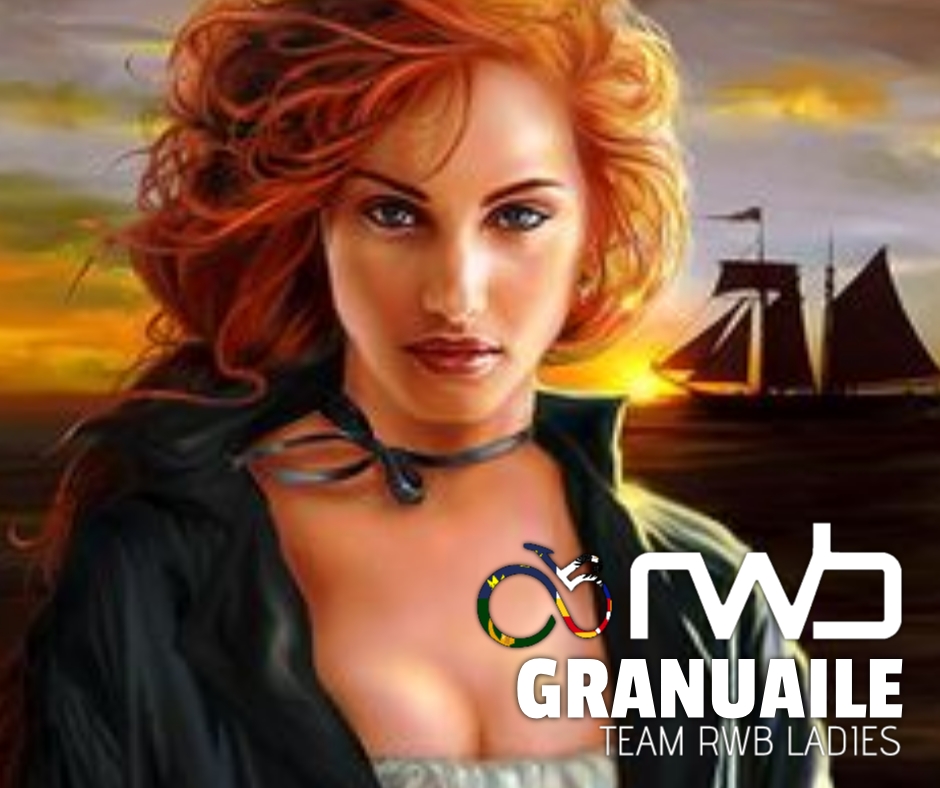
Granuaile | Our Women Racers
Granuaile, also known as the Pirate Queen and head of the O’Malley Clan.
Born around 1530, the daughter of a Gaelic chieftain, she excelled in the traditional seafaring attributes of her family – sea-trading to Ireland, Scotland and Spain, with some piracy and plundering on the side – before she assumed the more traditional role of wife and mother in a politically-arranged marriage.
As a child, legend has it that she cut off all her hair to disguise herself as a boy to steal onto one of her father’s ships as he set sail on a trading expedition. He had refused to take her because at that time, it was considered bad luck to have women on board at sea. This is the source of her name Gráinne Mhaol (or bald Gráinne), anglicised as Granuaile.
After she was married, convention again did not deter her, when she displaced her more reckless first husband in his role as chieftain and later avenged his death. Neither did it deter her from divorcing her second husband, from taking a lover or from reuniting with her husband to oppose the English. He seems to have been content to walk in her shadow.
When Gaelic law spurned her as a female chieftain, she endured the same danger and hardship as her followers. Her ability and success render ed the Salic code – which debarred women leaders – redundant. Her daring and charisma made her leader of an army of 200 men and captain of a fleet of galleys.
Fearless in battle, she personally led her army against English generals who tried to curb her power. Eventually she became matriarch or overlord, not merely of her own followers and extended family, but of neighbouring clansmen, whose chieftains had either died in the numerous conflicts of the period, or had abandoned their obligations to protect their dependent followers.
By 1593, she had a catalogue of rebellion, piracy and other “disloyal” activities as long as her arm registered against her at the English Court, and she bore the tags “nurse to all rebellions for forty years” and “a director of thieves and murderers at sea.” Nonetheless, she boldly sailed her galley from her castle on Clew Bay on the west coast of Ireland to Greenwich Palace to negotiate face-to-face with her perceived enemy Queen Elizabeth I. Granuaile persuaded the English queen to fly in the face of the advice of her own military men in Ireland and not only kept her head but ensured her family’s future security and her own freedom until her death in 1603.
Above all else, she emerges as a woman who broke the mould and thereby played a unique role in history.


